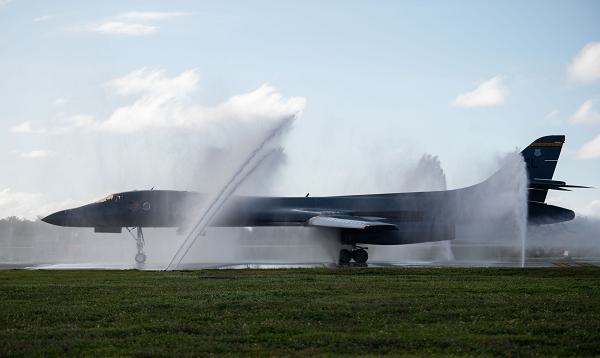
Andersen Air Force Base, Guam. (June 13, 2024): In this photo by Airman 1st Class Audree Campbell, a B-1B Lancer from the 37th Expeditionary Bomb Squadron receives a bath after returning from a practice mission. The Lancer dates to President Ronald Reagan in 1988 and has been the backbone of America’s long range bomber force ever since. It can rapidly deliver massive quantities of precision and non-precision weapons against any adversary, anywhere in the world, at any time.
A key feature of the Lancer is its swept wings which are set forward on takeoff and sweep back for supersonic flight. These wings give the B1-B incredible maneuverability and greater speeds, particularly at high altitudes. In addition to carrying a substantial payload, the Lancer has advanced radar targeting systems and the ability to “loiter” over an area for a substantial period. Using mid-air refueling, the Lancer can strike targets day or night and in all weather.
The Lancer has a synthetic aperture radar that is capable of tracking, targeting, and engaging moving vehicles and an extremely accurate Global Positioning System-aided Inertial Navigation System allowing aircrews to navigate without the aid of ground-based radars.
For self-defense, the B1-B carries electronic jamming equipment including a radar warning receiver and countermeasures like chaff or flares. These systems identify the full spectrum of threatening emissions and apply the appropriate jamming technique automatically.
During the first six months of Operation Enduring Freedom, eight B-1s dropped nearly 40 percent of the total tonnage delivered by coalition air forces. This included nearly 3,900 JDAMs, or 67 percent of the total. In Operation Iraqi Freedom, the aircraft flew less than 1 percent of the combat missions while delivering 43 percent of the JDAMs used.
The holder of nearly fifty world records for speed, payload, and range, the B1-B Lancer will continue to be the backbone of America’s long range bomber deterrent.


